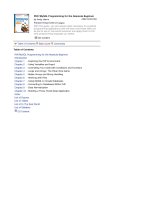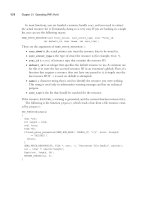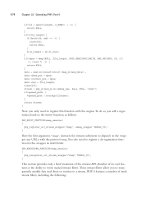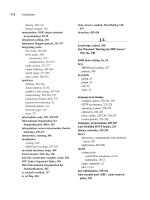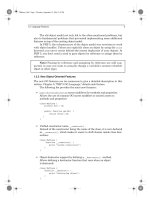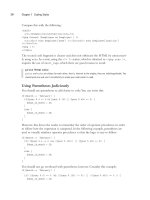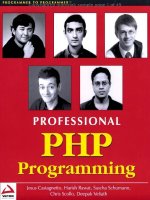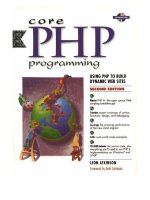programming php
Bạn đang xem bản rút gọn của tài liệu. Xem và tải ngay bản đầy đủ của tài liệu tại đây (3.32 MB, 540 trang )
Table of Contents
1Main Page
2Table of content
6Copyright
7Preface
8
Audience for This Book
9
Structure of This Book
10
Conventions Used in This Book
11
Comments and Questions
12
Acknowledgments
13Chapter 1. Introduction to PHP
14
1.1 What Does PHP Do?
15
1.2 A Brief History of PHP
19
1.3 Installing PHP
21
1.4 A Walk Through PHP
27Chapter 2. Language Basics
28
2.1 Lexical Structure
34
2.2 Data Types
40
2.3 Variables
44
2.4 Expressions and Operators
55
2.5 Flow-Control Statements
63
2.6 Including Code
65
2.7 Embedding PHP in Web Pages
68Chapter 3. Functions
69
3.1 Calling a Function
70
3.2 Defining a Function
72
3.3 Variable Scope
74
3.4 Function Parameters
77
3.5 Return Values
78
3.6 Variable Functions
79
3.7 Anonymous Functions
80Chapter 4. Strings
81
4.1 Quoting String Constants
84
4.2 Printing Strings
88
4.3 Accessing Individual Characters
89
4.4 Cleaning Strings
91
4.5 Encoding and Escaping
96
4.6 Comparing Strings
99
4.7 Manipulating and Searching Strings
105
4.8 Regular Expressions
109
4.9 POSIX-Style Regular Expressions
113
4.10 Perl-Compatible Regular Expressions
123Chapter 5. Arrays
124
5.1 Indexed Versus Associative Arrays
125
5.2 Identifying Elements of an Array
126
5.3 Storing Data in Arrays
129
5.4 Multidimensional Arrays
130
5.5 Extracting Multiple Values
134
5.6 Converting Between Arrays and Variables
135
5.7 Traversing Arrays
140
5.8 Sorting
144
5.9 Acting on Entire Arrays
146
5.10 Using Arrays
148Chapter 6. Objects
149
6.1 Terminology
150
6.2 Creating an Object
151
6.3 Accessing Properties and Methods
152
6.4 Declaring a Class
156
6.5 Introspection
162
6.6 Serialization
165Chapter 7. Web Techniques
166
7.1 HTTP Basics
167
7.2 Variables
168
7.3 Server Information
170
7.4 Processing Forms
180
7.5 Setting Response Headers
183
7.6 Maintaining State
191
7.7 SSL
192Chapter 8. Databases
193
8.1 Using PHP to Access a Database
195
8.2 Relational Databases and SQL
196
8.3 PEAR DB Basics
202
8.4 Advanced Database Techniques
207
8.5 Sample Application
215Chapter 9. Graphics
216
9.1 Embedding an Image in a Page
218
9.2 The GD Extension
219
9.3 Basic Graphics Concepts
220
9.4 Creating and Drawing Images
224
9.5 Images with Text
227
9.6 Dynamically Generated Buttons
230
9.7 Scaling Images
232
9.8 Color Handling
236Chapter 10. PDF
237
10.1 PDF Extensions
238
10.2 Documents and Pages
241
10.3 Text
249
10.4 Images and Graphics
257
10.5 Navigation
260
10.6 Other PDF Features
262Chapter 11. XML
263
11.1 Lightning Guide to XML
265
11.2 Generating XML
267
11.3 Parsing XML
277
11.4 Transforming XML with XSLT
280
11.5 Web Services
284Chapter 12. Security
285
12.1 Global Variables and Form Data
287
12.2 Filenames
289
12.3 File Uploads
291
12.4 File Permissions
294
12.5 Concealing PHP Libraries
295
12.6 PHP Code
297
12.7 Shell Commands
298
12.8 Security Redux
299Chapter 13. Application Techniques
300
13.1 Code Libraries
301
13.2 Templating Systems
304
13.3 Handling Output
306
13.4 Error Handling
310
13.5 Performance Tuning
316Chapter 14. Extending PHP
317
14.1 Architectural Overview
318
14.2 What You'll Need
319
14.3 Building Your First Extensions
326
14.4 The config.m4 File
328
14.5 Memory Management
330
14.6 The pval/zval Data Type
333
14.7 Parameter Handling
336
14.8 Returning Values
340
14.9 References
342
14.10 Global Variables
344
14.11 Creating Variables
346
14.12 Extension INI Entries
348
14.13 Resources
350
14.14 Where to Go from Here
351Chapter 15. PHP on Windows
352
15.1 Installing and Configuring PHP on Windows
355
15.2 Writing Portable Code for Windows and Unix
359
15.3 Interfacing with COM
366
15.4 Interacting with ODBC Data Sources
371Appendix A. Function Reference
372
A.1 PHP Functions by Category
375
A.2a Alphabetical Listing of PHP Functions (a-e)
392
A.2b Alphabetical Listing of PHP Functions (f-i)
409
A.2c Alphabetical Listing of PHP Functions (j-q)
423
A.3d Alphabetical Listing of PHP Functions (r-z)
441Appendix B. Extension Overview
442
B.1 Optional Extensions Listing
454
Colophone
455Index
456
Index SYMBOL
460
Index A
464
Index B
466
Index C
472
Index D
476
Index E
481
Index F
486
Index G
489
Index H
491
Index I
495
Index J
496
Index K
497
Index L
499
Index M
502
Index N
504
Index O
507
Index P
514
Index Q
515
Index R
518
Index S
525
Index T
527
Index U
529
Index V
531
Index W
533
Index X
535
Index Y
536
Index Z
I l@ve RuBoard
• Table of Contents
• Index
• Reviews
• Examples
• Reader Reviews
• Errata
Programming PHP
By Rasmus Lerdorf, Kevin Tatroe
Publisher: O'Reilly
Pub Date: March 2002
ISBN : 1-56592-610-2
Pages : 524
Programming PHP is a comprehensive guide to PHP, a simple yet powerful language for creating
dynamic web content. Filled with the unique knowledge of the creator of PHP, Rasmus Lerdorf, this book
is a detailed reference to the language and its applications, including such topics as form processing,
sessions, databases, XML, and graphics. Covers PHP 4, the latest version of the language.
I l@ve RuBoard
O'Reilly: Programming PHP Main Page
1 / 536
I l@ve RuBoard
• Table of Contents
• Index
• Reviews
• Examples
• Reader Reviews
• Errata
Programming PHP
By Rasmus Lerdorf, Kevin Tatroe
Publisher: O'Reilly
Pub Date: March 2002
ISBN : 1-56592-610-2
Pages : 524
Copyright
Preface
Audience for This Book
Structure of This Book
Conventions Used in This Book
Comments and Questions
Acknowledgments
Chapter 1. Introduction to PHP
Section 1.1. What Does PHP Do?
Section 1.2. A Brief History of PHP
Section 1.3. Installing PHP
Section 1.4. A Walk Through PHP
Chapter 2. Language Basics
Section 2.1. Lexical Structure
Section 2.2. Data Types
Section 2.3. Variables
Section 2.4. Expressions and Operators
Section 2.5. Flow-Control Statements
Section 2.6. Including Code
Section 2.7. Embedding PHP in Web Pages
Chapter 3. Functions
Section 3.1. Calling a Function
Section 3.2. Defining a Function
Section 3.3. Variable Scope
Section 3.4. Function Parameters
Section 3.5. Return Values
Section 3.6. Variable Functions
Section 3.7. Anonymous Functions
O'Reilly: Programming PHP Table of content
2 / 536
Chapter 4. Strings
Section 4.1. Quoting String Constants
Section 4.2. Printing Strings
Section 4.3. Accessing Individual Characters
Section 4.4. Cleaning Strings
Section 4.5. Encoding and Escaping
Section 4.6. Comparing Strings
Section 4.7. Manipulating and Searching Strings
Section 4.8. Regular Expressions
Section 4.9. POSIX-Style Regular Expressions
Section 4.10. Perl-Compatible Regular Expressions
Chapter 5. Arrays
Section 5.1. Indexed Versus Associative Arrays
Section 5.2. Identifying Elements of an Array
Section 5.3. Storing Data in Arrays
Section 5.4. Multidimensional Arrays
Section 5.5. Extracting Multiple Values
Section 5.6. Converting Between Arrays and Variables
Section 5.7. Traversing Arrays
Section 5.8. Sorting
Section 5.9. Acting on Entire Arrays
Section 5.10. Using Arrays
Chapter 6. Objects
Section 6.1. Terminology
Section 6.2. Creating an Object
Section 6.3. Accessing Properties and Methods
Section 6.4. Declaring a Class
Section 6.5. Introspection
Section 6.6. Serialization
Chapter 7. Web Techniques
Section 7.1. HTTP Basics
Section 7.2. Variables
Section 7.3. Server Information
Section 7.4. Processing Forms
Section 7.5. Setting Response Headers
Section 7.6. Maintaining State
Section 7.7. SSL
Chapter 8. Databases
Section 8.1. Using PHP to Access a Database
Section 8.2. Relational Databases and SQL
Section 8.3. PEAR DB Basics
Section 8.4. Advanced Database Techniques
Section 8.5. Sample Application
Chapter 9. Graphics
Section 9.1. Embedding an Image in a Page
Section 9.2. The GD Extension
Section 9.3. Basic Graphics Concepts
Section 9.4. Creating and Drawing Images
Section 9.5. Images with Text
Section 9.6. Dynamically Generated Buttons
O'Reilly: Programming PHP Table of content
3 / 536
Section 9.7. Scaling Images
Section 9.8. Color Handling
Chapter 10. PDF
Section 10.1. PDF Extensions
Section 10.2. Documents and Pages
Section 10.3. Text
Section 10.4. Images and Graphics
Section 10.5. Navigation
Section 10.6. Other PDF Features
Chapter 11. XML
Section 11.1. Lightning Guide to XML
Section 11.2. Generating XML
Section 11.3. Parsing XML
Section 11.4. Transforming XML with XSLT
Section 11.5. Web Services
Chapter 12. Security
Section 12.1. Global Variables and Form Data
Section 12.2. Filenames
Section 12.3. File Uploads
Section 12.4. File Permissions
Section 12.5. Concealing PHP Libraries
Section 12.6. PHP Code
Section 12.7. Shell Commands
Section 12.8. Security Redux
Chapter 13. Application Techniques
Section 13.1. Code Libraries
Section 13.2. Templating Systems
Section 13.3. Handling Output
Section 13.4. Error Handling
Section 13.5. Performance Tuning
Chapter 14. Extending PHP
Section 14.1. Architectural Overview
Section 14.2. What You'll Need
Section 14.3. Building Your First Extensions
Section 14.4. The config.m4 File
Section 14.5. Memory Management
Section 14.6. The pval/zval Data Type
Section 14.7. Parameter Handling
Section 14.8. Returning Values
Section 14.9. References
Section 14.10. Global Variables
Section 14.11. Creating Variables
Section 14.12. Extension INI Entries
Section 14.13. Resources
Section 14.14. Where to Go from Here
Chapter 15. PHP on Windows
Section 15.1. Installing and Configuring PHP on Windows
Section 15.2. Writing Portable Code for Windows and Unix
Section 15.3. Interfacing with COM
O'Reilly: Programming PHP Table of content
4 / 536
Section 15.4. Interacting with ODBC Data Sources
Appendix A. Function Reference
Section A.1. PHP Functions by Category
Section A.2a. Alphabetical Listing of PHP Functions (a-e)
Section A.2b. Alphabetical Listing of PHP Functions (f-i)
Section A.2c. Alphabetical Listing of PHP Functions (j-q)
Section A.3d. Alphabetical Listing of PHP Functions (r-z)
Appendix B. Extension Overview
Section B.1. Optional Extensions Listing
Colophon
Index
I l@ve RuBoard
O'Reilly: Programming PHP Table of content
5 / 536
I l@ve RuBoard
Copyright
Copyright © 2002 O'Reilly & Associates, Inc. All rights reserved.
Printed in the United States of America.
Published by O'Reilly & Associates, Inc., 1005 Gravenstein Highway North, Sebastopol, CA 95472.
O'Reilly & Associates books may be purchased for educational, business, or sales promotional use.
Online editions are also available for most titles (). For more information contact our
corporate/institutional sales department: 800-998-9938 or
Nutshell Handbook, the Nutshell Handbook logo, and the O'Reilly logo are registered trademarks of
O'Reilly & Associates, Inc. Many of the designations used by manufacturers and sellers to distinguish
their products are claimed as trademarks. Where those designations appear in this book, and O'Reilly &
Associates, Inc. was aware of a trademark claim, the designations have been printed in caps or initial
caps. The association between the image of a cuckoo and PHP is a trademark of O'Reilly & Associates,
Inc.
While every precaution has been taken in the preparation of this book, the publisher assumes no
responsibility for errors or omissions, or for damages resulting from the use of the information contained
herein.
I l@ve RuBoard
O'Reilly: Programming PHP Copyright
6 / 536
I l@ve RuBoard
Preface
Now, more than ever, the Web is a major vehicle for corporate and personal communications. Web sites
carry photo albums, shopping carts, and product lists. Many of those web sites are driven by PHP, an
open source scripting language primarily designed for generating HTML content.
Since its inception in 1994, PHP has swept over the Web. The millions of web sites powered by PHP are
testament to its popularity and ease of use. It lies in the sweet spot between Perl/CGI, Active Server
Pages (ASP), and HTML. Everyday people can learn PHP and can build powerful dynamic web sites with
it.
The core PHP language features powerful string- and array-handling facilities, as well as support for
object-oriented programming. With the use of standard and optional extension modules, a PHP
application can interact with a database such as MySQL or Oracle, draw graphs, create PDF files, and
parse XML files. You can write your own PHP extension modules in C�for example, to provide a PHP
interface to the functions in an existing code library. You can even run PHP on Windows, which lets you
control other Windows applications such as Word and Excel with COM, or interact with databases using
ODBC.
This book is a guide to the PHP language. When you finish this book, you will know how the PHP
language works, how to use the many powerful extensions that come standard with PHP, and how to
design and build your own PHP web applications.
I l@ve RuBoard
O'Reilly: Programming PHP Preface
7 / 536
I l@ve RuBoard
Audience for This Book
PHP is a melting pot of cultures. Web designers appreciate its accessibility and convenience, while
programmers appreciate its flexibility and speed. Both cultures need a clear and accurate reference to the
language.
If you're a programmer, this book is for you. We show the big picture of the PHP language, then discuss
the details without wasting your time. The many examples clarify the explanations, and the practical
programming advice and many style tips will help you become not just a PHP programmer, but a good
PHP programmer.
If you're a web designer, you'll appreciate the clear and useful guides to specific technologies, such as
XML, sessions, and graphics. And you'll be able to quickly get the information you need from the language
chapters, which explain basic programming concepts in simple terms.
This book does assume a working knowledge of HTML. If you don't know HTML, you should gain some
experience with simple web pages before you try to tackle PHP. For more information on HTML, we
recommend HTML & XHTML: The Definitive Guide, by Chuck Musciano and Bill Kennedy (O'Reilly).
I l@ve RuBoard
O'Reilly: Programming PHP Audience for This Book
8 / 536
I l@ve RuBoard
Structure of This Book
We've arranged the material in this book so that you can read it from start to finish, or jump around to hit
just the topics that interest you. The book is divided into 15 chapters and 2 appendixes, as follows.
Chapter 1 talks about the history of PHP and gives a lightning-fast overview of what is possible with PHP
programs.
Chapter 2 is a concise guide to PHP program elements such as identifiers, data types, operators, and
flow-control statements.
Chapter 3 discusses user-defined functions, including scoping, variable-length parameter lists, and
variable and anonymous functions.
Chapter 4 covers the functions you'll use when building, dissecting, searching, and modifying strings.
Chapter 5 details the notation and functions for constructing, processing, and sorting arrays.
Chapter 6 covers PHP's object-oriented features. In this chapter, you'll learn about classes, objects,
inheritance, and introspection.
Chapter 7 discusses web basics such as form parameters and validation, cookies, and sessions.
Chapter 8 discusses PHP's modules and functions for working with databases, using the PEAR DB library
and the MySQL database for examples.
Chapter 9 shows how to create and modify image files in a variety of formats from PHP.
Chapter 10 explains how to create PDF files from a PHP application.
Chapter 11 introduces PHP's extensions for generating and parsing XML data, and includes a section on
the web services protocol XML-RPC.
Chapter 12 provides valuable advice and guidance for programmers in creating secure scripts. You'll
learn best-practices programming techniques here that will help you avoid mistakes that can lead to
disaster.
Chapter 13 talks about the advanced techniques that most PHP programmers eventually want to use,
including error handling and performance tuning.
Chapter 14 is an advanced chapter that presents easy-to-follow instructions for building a PHP extension
in C.
Chapter 15 discusses the tricks and traps of the Windows port of PHP. It also discusses the features
unique to Windows, such as COM and ODBC.
Appendix A is a handy quick reference to all the core functions in PHP.
Appendix B describes the standard extensions that ship with PHP.
I l@ve RuBoard
O'Reilly: Programming PHP Structure of This Book
9 / 536
I l@ve RuBoard
Conventions Used in This Book
The following typographic conventions are used in this book:
Italic
Used for file and directory names, email addresses, and URLs, as well as for new terms where they
are defined.
Constant Width
Used for code listings and for keywords, variables, functions, command options, parameters, class
names, and HTML tags where they appear in the text.
Constant Width Bold
Used to mark lines of output in code listings.
Constant Width Italic
Used as a general placeholder to indicate items that should be replaced by actual values in your
own programs.
I l@ve RuBoard
O'Reilly: Programming PHP Conventions Used in This Book
10 / 536
I l@ve RuBoard
Comments and Questions
Please address comments and questions concerning this book to the publisher:
O'Reilly & Associates, Inc.
1005 Gravenstein Highway North
Sebastopol, CA 95472
(800) 998-9938 (in the United States or Canada)
(707) 829-0515 (international/local)
(707) 829-0104 (fax)
There is a web page for this book, which lists errata, examples, or any additional information. You can
access this page at:
/>To comment or ask technical questions about this book, send email to:
For more information about books, conferences, Resource Centers, and the O'Reilly Network, see the
O'Reilly web site at:
I l@ve RuBoard
O'Reilly: Programming PHP Comments and Questions
11 / 536
I l@ve RuBoard
Acknowledgments
All of the authors would like to thank the technical reviewers for their helpful comments on the content of
this book: Shane Caraveo, Andi Gutmans, and Stig Bakken. We'd also like to thank Andi Gutmans, Zeev
Suraski, Stig Bakken, Shane Caraveo, and Randy Jay Yarger for their contributions to early drafts of
material for this book.
Rasmus Lerdorf
I would like to acknowledge the large and wonderfully boisterous PHP community, without which there
would be no PHP today.
Kevin Tatroe
I'll err on the side of caution and thank Nat Torkington for dragging me into this project. ("You don't want to
write a book, it's a miserable experience Hey, want to write a book?") While I was writing, the denizens
of Nerdsholm and 3WA were always quick with help and/or snarky commentary, both of which contributed
to the book's completion. Without twice-monthly game sessions to keep me sane, I would surely have
given up well before the last chapter was delivered: thank you to my fellow players, Jenn, Keith, Joe, Keli,
Andy, Brad, Pete, and Jim.
Finally, and most importantly, a huge debt of gratitude is owed to Jennifer and Hadden, both of whom put
up with more neglect over the course of the past year than any good people deserve.
Bob Kaehms
Thanks to my wife Janet and the kids ( Jenny, Megan, and Bobby), to Alan Brown for helping me
understand the issues in integrating COM with PHP, and to the staff at Media Net Link for allowing me to
add this project to my ever-expanding list of extracurricular activities.
Ric McGredy
Thanks to my family for putting up with my absence, to Nat for inheriting the project while in the midst of
family expansion, and to my colleagues at Media Net Link for all their help and support.
I l@ve RuBoard
O'Reilly: Programming PHP Acknowledgments
12 / 536
I l@ve RuBoard
Chapter 1. Introduction to PHP
PHP is a simple yet powerful language designed for creating HTML content. This chapter covers
essential background on the PHP language. It describes the nature and history of PHP; which platforms it
runs on; and how to download, install, and configure it. This chapter ends by showing you PHP in action,
with a quick walkthrough of several PHP programs that illustrate common tasks, such as processing form
data, interacting with a database, and creating graphics.
I l@ve RuBoard
O'Reilly: Programming PHP Chapter 1. Introduction to PHP
13 / 536
I l@ve RuBoard
1.1 What Does PHP Do?
PHP can be used in three primary ways:
Server-side scripting
PHP was originally designed to create dynamic web content, and it is still best suited for that task.
To generate HTML, you need the PHP parser and a web server to send the documents. Lately, PHP
has also become popular for generating XML documents, graphics, Flash animations, PDF files, and
more.
Command-line scripting
PHP can run scripts from the command line, much like Perl, awk, or the Unix shell. You might use the
command-line scripts for system administration tasks, such as backup and log parsing.
Client-side GUI applications
Using PHP-GTK (), you can write full-blown, cross-platform GUI applications in
PHP.
In this book, we'll concentrate on the first item, using PHP to develop dynamic web content.
PHP runs on all major operating systems, from Unix variants including Linux, FreeBSD, and Solaris to
such diverse platforms as Windows and Mac OS X. It can be used with all leading web servers, including
Apache, Microsoft IIS, and the Netscape/iPlanet servers.
The language is very flexible. For example, you aren't limited to outputting just HTML or other text
files�any document format can be generated. PHP has built-in support for generating PDF files, GIF,
JPG, and PNG images, and Flash movies.
One of PHP's most significant features is its wide-ranging support for databases. PHP supports all major
databases (including MySQL, PostgreSQL, Oracle, Sybase, and ODBC-compliant databases), and even
many obscure ones. With PHP, creating web pages with dynamic content from a database is remarkably
simple.
Finally, PHP provides a library of PHP code to perform common tasks, such as database abstraction,
error handling, and so on, with the PHP Extension and Application Repository (PEAR). PEAR is a
framework and distribution system for reusable PHP components. You can find out more about it at
.
I l@ve RuBoard
O'Reilly: Programming PHP 1.1 What Does PHP Do?
14 / 536
I l@ve RuBoard
1.2 A Brief History of PHP
Rasmus Lerdorf first conceived of PHP in 1994, but the PHP that people use today is quite different from the
initial version. To understand how PHP got where it is today, it is useful to know the historical evolution of the
language. Here's that story, as told by Rasmus.
1.2.1 The Evolution of PHP
Here is the PHP 1.0 announcement that I posted to the Usenet newsgroup comp.infosystems.www.authoring.cgi
in June 1995:
From: (Rasmus Lerdorf)
Subject: Announce: Personal Home Page Tools (PHP Tools)
Date: 1995/06/08
Message-ID: <3r7pgp$>#1/1
organization: none
newsgroups: comp.infosystems.www.authoring.cgi
Announcing the Personal Home Page Tools (PHP Tools) version 1.0.
These tools are a set of small tight cgi binaries written in C.
They perform a number of functions including:
. Logging accesses to your pages in your own private log files
. Real-time viewing of log information
. Providing a nice interface to this log information
. Displaying last access information right on your pages
. Full daily and total access counters
. Banning access to users based on their domain
. Password protecting pages based on users' domains
. Tracking accesses ** based on users' e-mail addresses **
. Tracking referring URL's - HTTP_REFERER support
. Performing server-side includes without needing server support for it
. Ability to not log accesses from certain domains (ie. your own)
. Easily create and display forms
. Ability to use form information in following documents
Here is what you don't need to use these tools:
. You do not need root access - install in your ~/public_html dir
. You do not need server-side includes enabled in your server
. You do not need access to Perl or Tcl or any other script interpreter
. You do not need access to the httpd log files
The only requirement for these tools to work is that you have
the ability to execute your own cgi programs. Ask your system
administrator if you are not sure what this means.
The tools also allow you to implement a guestbook or any other
form that needs to write information and display it to users
later in about 2 minutes.
The tools are in the public domain distributed under the GNU
Public License. Yes, that means they are free!
For a complete demonstration of these tools, point your browser
at: />
Rasmus Lerdorf
/>Note that the URL and email address shown in this message are long gone. The language of this announcement
O'Reilly: Programming PHP 1.2 A Brief History of PHP
15 / 536
reflects the concerns that people had at the time, such as password-protecting pages, easily creating forms, and
accessing form data on subsequent pages. The announcement also illustrates PHP's initial positioning as a
framework for a number of useful tools.
The announcement talks only about the tools that came with PHP, but behind the scenes the goal was to create a
framework to make it easy to extend PHP and add more tools. The business logic for these add-ons was written
in C�a simple parser picked tags out of the HTML and called the various C functions. It was never my plan to
create a scripting language.
So, what happened?
I started working on a rather large project for the University of Toronto that needed a tool to pull together data
from various places and present a nice web-based administration interface. Of course, I decided that PHP would
be ideal for the task, but for performance reasons, the various small tools of PHP 1 had to be brought together
better and integrated into the web server.
Initially, I made some hacks to the NCSA web server, to patch it to support the core PHP functionality. The
problem with this approach was that as a user, you had to replace your web-server software with this special,
hacked-up version. Fortunately, Apache was starting to gain momentum around this time, and the Apache API
made it easier to add functionality like PHP to the server.
Over the next year or so, a lot was done and the focus changed quite a bit. Here's the PHP Version 2 (PHP/FI)
announcement I sent in April 1996:
From: (Rasmus Lerdorf)
Subject: ANNOUNCE: PHP/FI Server-side HTML-Embedded Scripting Language
Date: 1996/04/16
Newsgroups: comp.infosystems.www.authoring.cgi
PHP/FI is a server-side HTML embedded scripting language. It has built-in
access logging and access restriction features and also support for
embedded SQL queries to mSQL and/or Postgres95 backend databases.
It is most likely the fastest and simplest tool available for creating
database-enabled web sites.
It will work with any UNIX-based web server on every UNIX flavour out
there. The package is completely free of charge for all uses including
commercial.
Feature List:
. Access Logging
Log every hit to your pages in either a dbm or an mSQL database.
Having hit information in a database format makes later analysis easier.
. Access Restriction
Password protect your pages, or restrict access based on the refering URL
plus many other options.
. mSQL Support
Embed mSQL queries right in your HTML source files
. Postgres95 Support
Embed Postgres95 queries right in your HTML source files
. DBM Support
DB,DBM,NDBM and GDBM are all supported
. RFC-1867 File Upload Support
Create file upload forms
. Variables, Arrays, Associative Arrays
. User-Defined Functions with static variables + recursion
. Conditionals and While loops
Writing conditional dynamic web pages could not be easier than with
the PHP/FI conditionals and looping support
. Extended Regular Expressions
Powerful string manipulation support through full regexp support
. Raw HTTP Header Control
Lets you send customized HTTP headers to the browser for advanced
Features such as cookies.
O'Reilly: Programming PHP 1.2 A Brief History of PHP
16 / 536
. Dynamic GIF Image Creation
Thomas Boutell's GD library is supported through an easy-to-use set of
tags.
It can be downloaded from the File Archive at: <URL: />
Rasmus Lerdorf
This was the first time the term "scripting language" was used. PHP 1's simplistic tag-replacement code was
replaced with a parser that could handle a more sophisticated embedded tag language. By today's standards, the
tag language wasn't particularly sophisticated, but compared to PHP 1 it certainly was.
The main reason for this change was that few people who used PHP 1 were actually interested in using the C-
based framework for creating add-ons. Most users were much more interested in being able to embed logic
directly in their web pages for creating conditional HTML, custom tags, and other such features. PHP 1 users
were constantly requesting the ability to add the hit-tracking footer or send different HTML blocks conditionally.
This led to the creation of an if tag. Once you have if, you need else as well. And from there, it's a slippery
slope to the point where, whether you want to or not, you end up writing an entire scripting language.
By mid-1997, PHP Version 2 had grown quite a bit and had attracted a lot of users, but there were still some
stability problems with the underlying parsing engine. The project was also still mostly a one-man effort, with a
few contributions here and there. At this point, Zeev Suraski and Andi Gutmans in Tel Aviv volunteered to rewrite
the underlying parsing engine, and we agreed to make their rewrite the base for PHP Version 3. Other people
also volunteered to work on other parts of PHP, and the project changed from a one-person effort with a few
contributors to a true open source project with many developers around the world.
Here is the PHP 3.0 announcement from June 1998:
June 6, 1998 The PHP Development Team announced the release of PHP 3.0,
the latest release of the server-side scripting solution already in use on
over 70,000 World Wide Web sites.
This all-new version of the popular scripting language includes support
for all major operating systems (Windows 95/NT, most versions of Unix,
and Macintosh) and web servers (including Apache, Netscape servers,
WebSite Pro, and Microsoft Internet Information Server).
PHP 3.0 also supports a wide range of databases, including Oracle, Sybase, Solid,
MySQ, mSQL, and PostgreSQL, as well as ODBC data sources.
New features include persistent database connections, support for the
SNMP and IMAP protocols, and a revamped C API for extending the language
with new features.
"PHP is a very programmer-friendly scripting language suitable for
people with little or no programming experience as well as the
seasoned web developer who needs to get things done quickly. The
best thing about PHP is that you get results quickly," said
Rasmus Lerdorf, one of the developers of the language.
"Version 3 provides a much more powerful, reliable and efficient
implementation of the language, while maintaining the ease of use and
rapid development that were the key to PHP's success in the past",
added Andi Gutmans, one of the implementors of the new language core.
"At Circle Net we have found PHP to be the most robust platform for
rapid web-based application development available today," said Troy
Cobb, Chief Technology Officer at Circle Net, Inc. "Our use of PHP
has cut our development time in half, and more than doubled our client
satisfaction. PHP has enabled us to provide database-driven dynamic
solutions which perform at phenomenal speeds."
PHP 3.0 is available for free download in source form and binaries for
several platforms at />O'Reilly: Programming PHP 1.2 A Brief History of PHP
17 / 536
The PHP Development Team is an international group of programmers who
lead the open development of PHP and related projects.
For more information, the PHP Development Team can be contacted at
After the release of PHP 3, usage really started to take off. Version 4 was prompted by a number of developers
who were interested in making some fundamental changes to the architecture of PHP. These changes included
abstracting the layer between the language and the web server, adding a thread-safety mechanism, and adding a
more advanced, two-stage parse/execute tag-parsing system. This new parser, primarily written by Zeev and
Andi, was named the Zend engine. After a lot of work by a lot of developers, PHP 4.0 was released on May 22,
2000.
Since that release, there have been a few minor releases of PHP 4, with the latest version as of this writing being
4.1.1. As this book goes to press, there is talk of PHP Version 5, which is likely to improve the internals of PHP's
object system.
1.2.2 The Growth of PHP
Figures 1-1 and 1-2 show the growth of PHP as measured by the usage numbers collected by Netcraft
() since early 1998. Figure 1-1 shows the total number of unique IP addresses that report
they are using Apache with the PHP module enabled. In November 2001, this number went beyond the one-
million mark. The slight dip at the end of 2001 reflects the demise of a number of dot-coms that disappeared from
the Web. The overall number of servers that Netcraft found also went down for the first time during this period.
Figure 1-1. The growth of PHP IP addresses
Figure 1-2 shows the number of actual domains that report they are using the PHP module. In November 2001,
when Netcraft found 36,458,394 different domains, 7,095,691 ( just under 20%) of them were found to have PHP
enabled. The domain figures represent the number of web sites using PHP, whereas IP addresses represent the
number of physical servers running PHP.
Figure 1-2. The growth of PHP domains
I l@ve RuBoard
O'Reilly: Programming PHP 1.2 A Brief History of PHP
18 / 536
I l@ve RuBoard
1.3 Installing PHP
PHP is available for many operating systems and platforms. The most common setup, however, is to use PHP as a
module for the Apache web server on a Unix machine. This section briefly describes how to install Apache with PHP.
If you're interested in running PHP on Windows, see Chapter 15, which explains your many options.
To install Apache with PHP, you'll need a Unix machine with an ANSI-compliant C compiler, and around 5 MB of
available disk space for source and object files. You'll also need Internet access to fetch the source code for PHP and
Apache.
Start by downloading the source distributions of PHP and Apache. The latest files are always available from
and , respectively. Store the files in the same directory, so that you have:
-rw-r r 1 gnat wheel 2177983 Oct 9 09:34 apache_1.3.22.tar.gz
-rw-r r 1 gnat wheel 3371385 Dec 10 14:29 php-4.1.1.tar.gz
Now uncompress and extract the distributions:
# gunzip -c apache_1.3.22.tar.gz | tar xf -
# gunzip -c php-4.1.1.tar.gz | tar xf -
Each distribution unpacks into its own subdirectory, as follows:
drwxr-xr-x 8 gnat wheel 512 Dec 16 11:26 apache_1.3.22
drwxr-xr-x 16 gnat wheel 2048 Dec 21 23:48 php-4.1.1
The next step is to configure Apache, then configure PHP, telling it where the Apache source is and specifying the
various other features that you want built into PHP. You'll probably want to customize the configurations of Apache
and PHP. For instance, provide the prefix=/some/path option to Apache's configure to change where Apache
expects its configuration files and utilities. Similarly, typical options for PHP include with-apache to identify the
location of the Apache source tree, enable-inline-optimizations to enable compilation options that give a
faster PHP interpreter, and with-mysql to identify where MySQL was installed. Each configuration creates
detailed output as it goes:
# cd apache_1.3.22
# ./configure prefix=/usr/local/apache
Configuring for Apache, Version 1.3.22
+ using installation path layout: Apache (config.layout)
Creating Makefile
Creating Configuration.apaci in src
Creating Makefile in src
+ configured for FreeBSD 4.2 platform
+ setting C compiler to gcc
# cd /php-4.1.1
# ./configure with-apache= /apache_1.3.22 enable-inline-optimization \
with-mysql=/usr
creating cache ./config.cache
checking for a BSD compatible install /usr/bin/install -c
checking whether build environment is sane yes
checking whether make sets ${MAKE} yes
checking for working aclocal missing
checking for working autoconf found
checking for working automake missing
checking for working autoheader found
checking for working makeinfo found
Updated php_version.h
For a full list of available configure options for each package, see the output of:
./configure help
Now you can build and install PHP:
# make
O'Reilly: Programming PHP 1.3 Installing PHP
19 / 536
# make install
These commands also install the PEAR libraries and copy the compiled Apache module to the Apache source tree.
Finally, change directory back to the Apache directory. Reconfigure Apache, telling it about the newly built PHP
module, and compile and install it:
# cd /apache_1.3.22
# ./configure prefix=/usr/local/apache activate-module=src/modules/php4/libphp4.a
# make
# make install
You now have Apache installed in /usr/local/apache, with PHP enabled. You also have PHP's extensions installed
(probably in /usr/local/lib/php). You still need to configure the web server to process .php pages with the PHP
interpreter, and start the web server. You may also want to change the PHP configuration.
Note that if you already have Apache installed and running on your server, it is possible to add PHP to the existing
Apache instance without recompiling it. These days, this is actually the most common way to build PHP. Instead of
using with-apache on your configure line, use with-apxs. You don't need the Apache source code in this
case; only the apxs script needs to be available on your server. Most Linux distributions include this script and the
corresponding files in their apache-devel packages.
PHP's configuration goes in a file called php.ini. The settings in this file control the behavior of PHP features, such as
session handling and form processing. Later chapters will refer to php.ini options, but in general the code in this book
does not require a customized configuration. See for more
information on php.ini configuration.
Once you have a web server, you'll need to tell it that .php files are to be handled by the PHP module. Put this in
Apache's httpd.conf file, and restart the web server:
AddType application/x-httpd-php .php
The PHP and Apache source directories both include files called INSTALL that contain detailed instructions on
troubleshooting and building those programs. If you want a nonstandard installation, or if you encounter problems
with the instructions presented here, be sure to read the INSTALL files.
I l@ve RuBoard
O'Reilly: Programming PHP 1.3 Installing PHP
20 / 536
I l@ve RuBoard
1.4 A Walk Through PHP
PHP pages are HTML pages with PHP commands embedded in them. This is in contrast to many other
dynamic web-page solutions, which are scripts that generate HTML. The web server processes the PHP
commands and sends their output (and any HTML from the file) to the browser. Example 1-1 shows a
complete PHP page.
Example 1-1. hello.php
<html>
<head>
<title>Look Out World</title>
</head>
<body>
<?php echo 'Hello, world!' ?>
</body>
</html>
Save the contents of Example 1-1 to a file, hello.php, and point your browser to it. The results appear in
Figure 1-3.
Figure 1-3. Output of hello.php
The PHP echo command produces output (the string "Hello, world!"), which is inserted into the HTML
file. In this example, the PHP code is placed between <?php and ?> tags. There are other ways to tag
your PHP code�see Chapter 2 for a full description.
1.4.1 Configuration Page
The PHP function phpinfo( ) creates an HTML page full of information on how PHP was installed.
You can use it to see whether you have particular extensions installed, or whether the php.ini file has
been customized. Example 1-2 is a complete page that displays the phpinfo( ) page.
Example 1-2. Using phpinfo( )
<?php phpinfo( ); ?>
Figure 1-4 shows the first part of the output of Example 1-2.
Figure 1-4. Partial output of phpinfo( )
O'Reilly: Programming PHP 1.4 A Walk Through PHP
21 / 536
